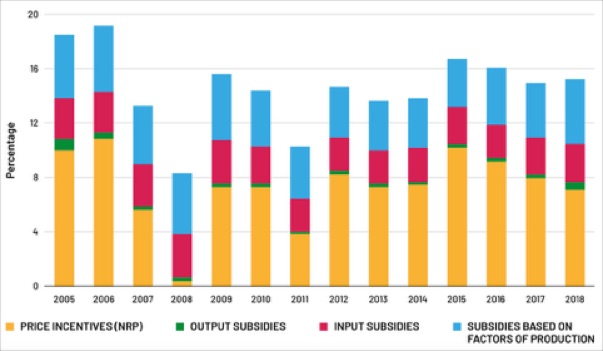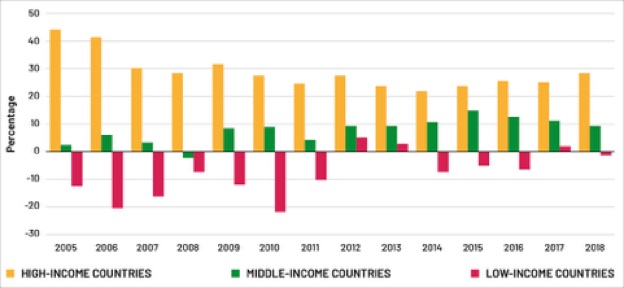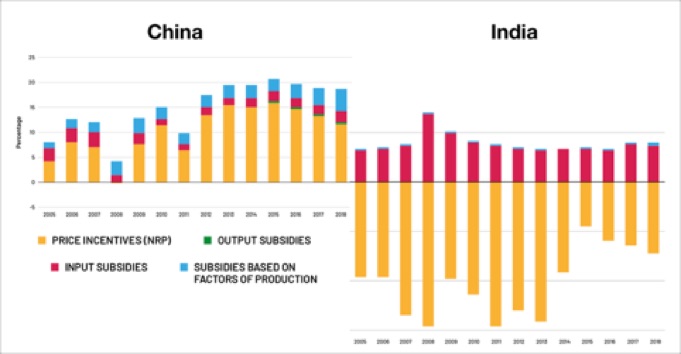News
16 October 2021
Public support to agriculture has been promoting unhealthy and polluting products and generating more inequality in the world
Today the world is celebrating the 41st World Food Day. The theme of the day is: “Our actions are our Future. The food you choose and the way you consume it affects our health and that of our planet. It has an impact on how agri-food systems work. So you need to be part of the change”.
Rightly and importantly so!
At hungerexplained.org, we would like to take this opportunity to review one aspect of what governments have been doing in the field of agriculture: the support they have been giving to agriculture through various types of incentives.
Through their policies (e.g. trade policies) and by spending public monies, governments can provide incentives to farmers and influence their behaviour, thus affecting the way food systems operate, including in terms of our health and the quality of our environment. Let’s see in which direction government support to agriculture has been guiding the agriculture sector worldwide.
What kind of incentives have our governments being using to guide agriculture?
A study published earlier this year by three UN agencies (FAO, UNDP and UNEP) provides useful elements to formulate an answer to this important question.
According to this document, the support given to agriculture every year is of almost $540 billion. This represents around 15% of the total value of global agricultural production. In some countries this share can be much more: in the European Union, for example in 2005, the support to agriculture was worth more than 40 percent of total value of agricultural production. According to the authors of the UN report, if the trend continues, this amount could reach $1,800 billion by 2030, equivalent to the current GDP of Canada or South Korea, the 9th and 10th world economic powers!
The incentives provided to agriculture have been particularly significant in rich countries, but they have also been gaining importance in some middle-income countries (e.g. China, Indonesia and Turkey). The support given consisted mainly of:
-
•Price incentives through border measures (tariffs levied on traded goods, quota applied to limit imports, bans or subsidies on exported goods) and price regulations (price fixation and market interventions to guarantee floor prices) - altogether estimated at nearly $300 billion every year.
-
•Fiscal subsidies (almost $250 billion, annually), of which around $90 billion on agricultural input and $10 billion on outputs. Approximately $150 billion are used for factors of production (mainly land and capital), half of which being paid on condition that farmers plant specific crops or maintain particular livestock herds. This also includes the provision of loans with reduced interest rates. Part of this, $70 billion subsidies are disbursed directly to farmers and they are not linked to any productive activity.
-
•Lastly, governments spend $110 billion on general sector services (e.g. research, development, health control).
Importance of various types support to agriculture between 2005 and 2018 (in percent of global production value)

Source: FAO, UNDP and UNEP study
download picture: Support.jpg
What matters here is, which agricultural products or activities are being actually supported in this way.
Where did the support go? They went to unhealthy or polluting products, and were responsible to put farmers in poor countries at a disadvantage
The most supported goods include sugar (an item known to have a particularly negative impact on human health) [read], rice, meat and cotton (the two former causing a large share of GHG emissions from agriculture, and the latter making extensive use of pesticides), all of which are widely consumed in rich countries and increasingly in emerging countries. On the contrary, most penalized goods comprise bananas, sorghum, tea and cocoa beans, products of which most are predominantly originating from poor countries and imported by rich countries.
Most supported and most penalized products (weighted average, 2005–2018)

Source: FAO, UNDP and UNEP report
The people who benefited most have been producers in rich countries and this has put at a disadvantage farmers in poor countries who actually get a negative support and face problems to compete with subsidized goods imported from rich countries (e.g. milk powder, poultry meat and wheat) (see diagramme below).
The way agriculture is being supported currently is in favour of producers living in rich and emerging countries, and to the detriment of those in poor countries. Support to agriculture, as it occurs now, clearly generate more inequality in the world.
In poor countries, mostly in sub-Saharan Africa, farmers are penalized (with the exception of years 2012 and 2013). Governments tend to limit producer prices, because a large share of their population is poor and the affordability of food is a key concern, particularly in urban areas [read]. This policy results in a ‘transfer’ of resources away from producers to consumers, who benefit from lower food prices. Certain governments, however, provide some input subsidies that have negative consequences on the environment.
In food-importing countries, incentives are often given to food staples, with the aim of shielding farmers from international competition, with the view to diminish dependence on imports and become more self-reliant. This, though, does not prevent governments from keeping borders open to imports so as to maintain consumer prices low in urban areas and avoid civil disturbances in these sensitive areas. The balance for producers, particularly in poor countries, is that they find themselves at a disadvantage.
Exporting countries tend to favour fiscal subsidies rather than other measures, in order to be more competitive on world markets. This corresponds to a transfer of value to consumers in importing countries.
In rich countries, support to agriculture relative to the total value of production has been going down of late, and there have been attempts to repurpose it towards less harmful goods and use the resources for funding general sector services.
In middle income countries, support to agriculture is rising and consists predominantly of price incentives, followed by input subsidies and subsidies based on production factors.
Support provided to agriculture in different income-level country groups
between 2005 and 2018 (in percent of global production value)

Source: FAO, UNDP and UNEP report
download picture: Groups.png
In China, support to agriculture has continuously been positive in recent years, made of price incentives as well as of output and input subsidies.
In India, on the contrary, net support has always been negative, as input subsidies were far from compensating prices disincentives (see diagramme below), a situation similar to what is observed in most poor countries where the very limited public resources used for paying subsidies on agricultural inputs to farmers (a few percent of the value of agricultural production) are considerably smaller than the price disincentives on their produce which have been negative by more than 10 percent of total value of the sector’s production in 5 years during the 2005-2018 period. There has been a positive support by a few percentage points in only three years (2012, 2013 and 2017).
Importance of various types support to agriculture in China and India
between 2005 and 2018 (in percent of their total production value)

Source: FAO, UNDP and UNEP report
download picture: China_and_India.jpg
Conclusion
In rich and emerging countries, governments have been supporting agriculture in a way that has been unfavourable to human health and to the protection of the environment. The support provided to agriculture worldwide has also been putting producers in poor countries at a disadvantage.
In poor countries, farmers are generally not supported by governments. They have to face competition from heavily subsidized imports from rich and emerging countries, and only benefit from minimal incentives for using agricultural inputs that are often bad for the environment. Moreover, part of the very limited support they get is used for subsidizing exports, a process that can be seen as a transfer of wealth to consumers in importing countries.
It is clear from the evidence provided by the UN study that a transition to more sustainable food systems (economically, socially and environmentally) will require a total reengineering of current support policies. There are some signs that changes are taking place in that direction in rich countries, but this is just a feeble beginning of what is really necessary.
—————————————
To know more :
-
•FAO, UNDP and UNEP, A multi-billion-dollar opportunity – Repurposing agricultural support to transform food systems, Rome, FAO, 2021.
-
•Monitoring and Analysing Food and Agricultural Policies (MAFAP), FAO, Website.
-
•OECD - Agricultural support, Website.
Selection of past articles on hungerexplained.org related to the topic:
Last update: October 2021
For your comments and reactions: hungerexpl@gmail.com


